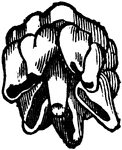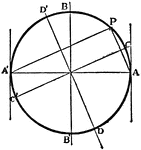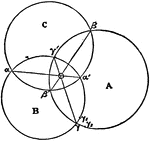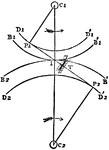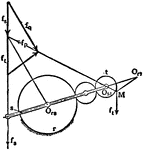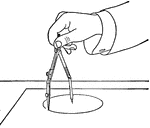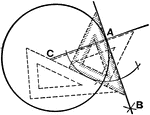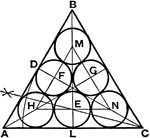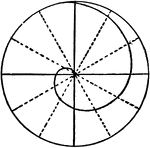
Irregular Curves
"Curves other than arcs of circles are drawn with the pencil or ruling pen by means of curved or irregular-shaped…

English Coin
"The pennies of the Saxon and Danish sole monarches of England had a portrait on them. Alfred's earlier…
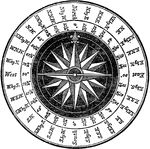
Compass Card
"Three principal parts, the card, the needle on its lower suface, and the case. The whole is enclosed…
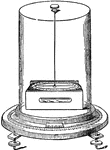
Astatic Multiplier
"The coil is of flat, rectangular shape, with a narrow central opening just large enough to allow one…

Altazimuth Theodolite
"An altazimuth theodolite of an improved pattern now used on the Ordnance Survey. The horizontal circle…

Zenith Telescope
"The instrument is supported on a strong tripod, fitted with levelling screws; to this tripod is fixed…

Dividing Engine
"The plate A is 46 inches in diameter, and is composed of gun metal. These were put on by original graduation,…
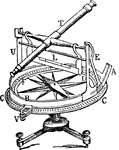
Declinometer
"Upon a tripod provided with levelling screws stands the pillar P, to which is fixed the graduated azimuthal…

Revolving Light
"In order to produce, on the catoptric system, a fixed light showing all round the circle, a number…
Wheel Barometer
"The whole length of the tube of the wheel barometer, from C to A, is 34 or 35 inches, and it is filled…
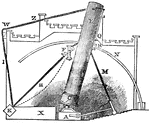
Telescope
"The following description of a section of Lord Rosse's telescope, though not so perfect as could be…
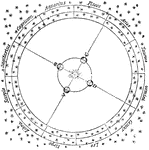
Zodiac Signs
"The twelve signs of the zodiac, together with the Sun, and the Earth revolving around him. When the…
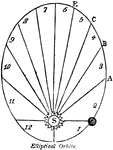
Elliptical Orbit
"The elliptical circle being supposed to be the Earth's orbit, with the Sun, S, in one of the foci.…
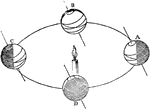
Earth Axis
"Now it is the inclination of the Earth's axis, as above described, which causes the lengths of the…

Earth Axis
"Now it is the inclination of the Earth's axis, as above described, which causes the lengths of the…

Seasons
"Suppose the Earth to be in her Summer solstice, which takes place on the 21st of June. At this period…

Moon Phases
"Let S be the Sun, E the Earth, and A, B, C, D, F, the Moon in different parts of her orbit. Now when…

Micrometer
"a is the sphere, placed in half-holes on the axis bb, so that when its principal axis is parallel to…

Micrometer
"a is the sphere, placed in half-holes on the axis bb, so that when its principal axis is parallel to…
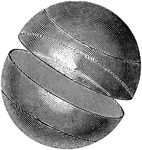
Great Circle
A Great Circle is one which would be formed on the earth's surface by a plane passing through the earth's…
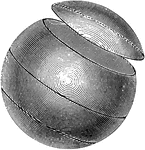
Small Circle
A small circle is one formed by a plane which does not cut the earth into two equal parts. The small…

Meridians and Parallels
The Meridian of any given place is that half of the meridian circle which passes through that place…
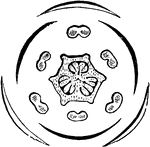
Trillium
Diagram of flower of Trillium. In this, as in all such diagrams of cross-section of blossoms, the parts…
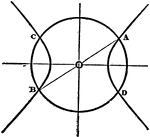
Conic Axes
Conjugate diameters perpendicular to each other are called, axes, and the points where they cut the…

Conic Foci Involution
The lines joining any point on a conic to the two foci are equally inclined to the tangent and normal…
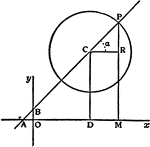
Straight Line
The straight line is the simplest type of locus and the simplest first degree equation.
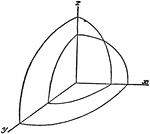
Octant of Wave Surface
the octant of the wave surface cuts each coordinate plane in a circle and an ellipse.
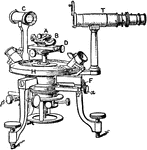
Horizontal-Circle Goniometer
The goniometer is an instrument for measuring the angles of crystals. Nicolaus Stena in 1669 determined…

Vertical Circle Goniometer
The goniometer is an instrument for measuring the angles of crystals. Nicolaus Stena in 1669 determined…

Magic Circle of Circles
The magic circle of circles, first developed by Benjamin Franklin, consists of eight annular rings and…
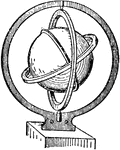
Gyroscope
Three suspended concentric circles free to move independently of each other at right angles.
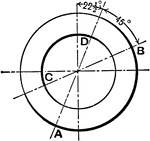
Drawing Lines 4
Circles should be unshaded or shaded evenly with thick and thin lines, changing at about 45 degrees.

Circle to Circle Tangents
Equal circles inside and tangent to the outside circle, also tangent to each other

Conic Sections 2D
Two dimensional view of the cuts required to create the conic sections hyperbola, parabola, ellipse,…
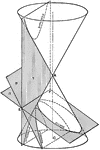
Conic Sections 3D
Three dimensional representation of the intersecting planes required to create the conic sections hyperbola,…
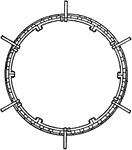
Shaft lining
"Until hard rock is reached the sides of the excavation are supported temporarily by a lining"—Finley,…
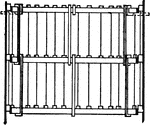
Shaft lining
"Until hard rock is reached the sides of the excavation are supported temporarily by a lining"—Finley,…
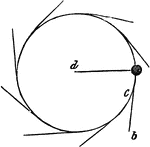
Centrifugal Force
"Suppose a cannon ball, tied with a string to the centre of a slab of smooth marble, and suppose an…
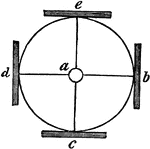
Sound Reflection in a Circle
"In a circle, sound is reflected from every plane surface placed around it, and hence, if the sound…
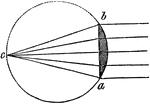
Plano Convex Lens
"If the whole circle be considered the circumfrence of a sphere, of which the plano-convex lens b, a,…
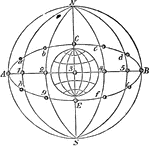
Suns in the Equator and Ecliptic
"Were the Earth's orbit a perfect circle, and her axis perpendicular to the plane of this orbit, the…
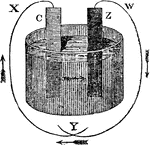
Galvanic Battery
"If we take for example, a slip of zinc, and another of copper, and place the in a cup of diluted sulphuric…
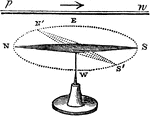
Uniting Wire above the Needle
"The instant this is done and the galvanic circle completed, the needle will deviate from its north…
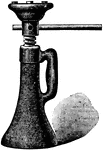
Screw with Lever Arm
"The power is generally applied by a wheel or a lever, and moves through the circumfrence of a circle.…
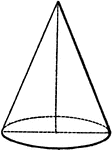
Cone
"A cone is a solid whose base is a circle and whose convex surface tapers uniformly to a point." —Hallock…

